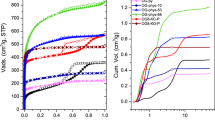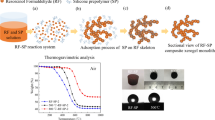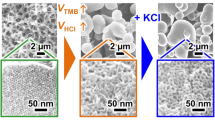Abstract
Here we report the adaptation of formaldehyde crosslinked phenolic resin-based aerogel and xerogel synthesis to ethanol-based solvent systems. Three specific formulations, namely one resorcinol–formaldehyde (RF) and two resorcinol–melamine–formaldehyde (RMF) systems were studied. As-prepared resins were characterized in terms of envelope and skeletal density. Furthermore, resin samples were pyrolyzed and activated in a CO2 gas atmosphere using a single-step protocol. The corresponding carbon materials featured high surface areas, moderate water uptake capacity and thermal conductivities in the 0.1 W.m−1K−1 range, in line with comparable activated carbons. The amount of formaldehyde in the synthesis of the RMF derived carbons proved to be a critical parameter in terms of both structural features and amount of N dopant in the carbonaceous matrix. Furthermore, a high formaldehyde concentration also has a drastic effect on the pore structure of the corresponding RMF carbons, leading primarily to mesopore formation without almost any macropore formation. Perhaps more importantly, the effect of the ammonia curing catalyst concentration on the material microstructure showed the opposite effect as observed in classical, water-based phenolic resin preparations. The ethanol-based synthesis clearly affects the pore structure of the resulting materials but also opens up the possibility to create inorganic/organic hybrid materials by simple combination with classical alkoxide-based silica sol–gel chemistry.

Highlights
-
Transposition of a porous phenolic resin recipe from an aqueous to an ethanolic environment.
-
Improvement of Nitrogen retention rate through pyrolysis and activation.
-
One-step combined heat treatment to create microporosity.
-
Compatibilization with inorganic systems such as alkoxysilanes.
-
Results differ from current literature in some way.







Similar content being viewed by others
References
Kubota M, Ito T, Watanabe F, Matsuda H (2011) Pore structure and water adsorptivity of petroleum coke-derived activated carbon for adsorption heat pump–Influence of hydrogen content of coke. Appl Therm Eng 31(8–9):1495–1498. https://doi.org/10.1016/j.applthermaleng.2011.01.036
Shimooka S et al. (2007) Improvement of water adsorptivity of activated carbon for adsorption heat pump by hydrophilic treatment. Proc Int Symp EcoTopia Sci
Kawano T, Kubota M, Onyango MS, Watanabe F, Matsuda H (2008) Preparation of activated carbon from petroleum coke by KOH chemical activation for adsorption heat pump. Appl Therm Eng 28(8–9):865–871. https://doi.org/10.1016/j.applthermaleng.2007.07.009
Pekala RW (1989) Organic aerogels from the polycondensation of resorcinol with formaldehyde. J Mater Sci 24(9):3221–3227
Wang H, Bo X, Zhang Y, Guo L (2013) Sulfur-doped ordered mesoporous carbon with high electrocatalytic activity for oxygen reduction. Electrochim Acta 108:404–411. https://doi.org/10.1016/j.electacta.2013.06.133
Paraknowitsch JP, Thomas A (2013) Doping carbons beyond nitrogen: an overview of advanced heteroatom doped carbons with boron, sulphur and phosphorus for energy applications. Energy Environ Sci 6(10):2839. https://doi.org/10.1039/c3ee41444b
Lermontov SA et al. (2017) Facile synthesis of fluorinated resorcinol-formaldehyde aerogels. J Fluor Chem 193:1–7. https://doi.org/10.1016/j.jfluchem.2016.11.001
Ding S, Zheng S, Xie M, Peng L, Guo X, Ding W (2011) One-pot synthesis of boron-doped mesoporous carbon with boric acid as a multifunction reagent. Microporous Mesoporous Mater 142(2–3):609–613. https://doi.org/10.1016/j.micromeso.2011.01.003
Rao CNR, Gopalakrishnan K, Govindaraj A (2014) Synthesis, properties and applications of graphene doped with boron, nitrogen and other elements. Nano Today 9(3):324–343. https://doi.org/10.1016/j.nantod.2014.04.010
Liu X et al. (2014) From melamine–resorcinol–formaldehyde to nitrogen-doped carbon xerogels with micro- and meso-pores for lithium batteries. J Mater Chem A 2(35):14429–14438. https://doi.org/10.1039/C4TA02928C
Principe IA, Fletcher AJ (2018) Parametric study of factors affecting melamine-resorcinol-formaldehyde xerogels properties. Mater Today Chem 7:5–14. https://doi.org/10.1016/j.mtchem.2017.11.002
Salinas-Torres D, Léonard AF, Stergiopoulos V, Busby Y, Pireaux J-J, Job N (2018) Effect of nitrogen doping on the pore texture of carbon xerogels based on resorcinol-melamine-formaldehyde precursors. Microporous Mesoporous Mater 256:190–198. https://doi.org/10.1016/j.micromeso.2017.08.004
Huber L et al. (2016) Water sorption behavior of physically and chemically activated monolithic nitrogen doped carbon for adsorption cooling. RSC Adv 6(84):80729–80738. https://doi.org/10.1039/C6RA18660B
Fu R et al. (2003) The fabrication and characterization of carbon aerogels by gelation and supercritical drying in isopropanol. Adv Funct Mater 13(7):558–562. https://doi.org/10.1002/adfm.200304289
Kiciński W, Norek M, Jankiewicz BJ (2014) Heterogeneous carbon gels: N-doped carbon xerogels from resorcinol and N-containing heterocyclic aldehydes. Langmuir 30(47):14276–14285. https://doi.org/10.1021/la503207t
Liu C, Li L, Song H, and Chen X (2007) Facile synthesis of ordered mesoporous carbons from F108/resorcinol–formaldehyde composites obtained in basic media. Chem Commun, 7:757–759. https://doi.org/10.1039/B614199D
Iswar S, Malfait WJ, Balog S, Winnefeld F, Lattuada M, Koebel MM (2017) Effect of aging on silica aerogel properties. Microporous Mesoporous Mater 241:293–302. https://doi.org/10.1016/j.micromeso.2016.11.037
Sing SW et al. (2008) Reporting Physisorption Data for Gas/Solid Systems. In: Handbook of Heterogeneous Catalysis, Weinheim (Eds), Wiley-VCGVerlag GmbH & Co. KGaA
Ahmadpour A, Do DD (1996) The preparation of active carbons from coal by chemical and physical activation. Carbon 34(4):471–479
Martinez-Escandell M, de Castro MM, Molina-Sabio M, Rodriguez-Reinoso F (2013) KOH activation of carbon materials obtained from the pyrolysis of ethylene tar at different temperatures. Fuel Process Technol 106:402–407. https://doi.org/10.1016/j.fuproc.2012.09.005
Mohamed AR, Mohammadi M, Darzi GN (2010) Preparation of carbon molecular sieve from lignocellulosic biomass: a review. Renew Sustain Energy Rev 14(6):1591–1599. https://doi.org/10.1016/j.rser.2010.01.024
Rodriguez-Reinoso F, Molina-Sabio M (1992) Activated carbons from lignocellulosic materials by chemical and/or physical activation: an overview. Carbon 30(7):1111–1118
Okada K, Yamamoto N, Kameshima Y, Yasumori A (2003) Porous properties of activated carbons from waste newspaper prepared by chemical and physical activation. J Colloid Interface Sci 262(1):179–193. https://doi.org/10.1016/S0021-9797(03)00107-3
Guo S et al. (2009) Effects of CO2 activation on porous structures of coconut shell-based activated carbons. Appl Surf Sci 255(20):8443–8449. https://doi.org/10.1016/j.apsusc.2009.05.150
Betancur M, Martínez JD, Murillo R (2009) Production of activated carbon by waste tire thermochemical degradation with CO2. J Hazard Mater 168(2–3):882–887. https://doi.org/10.1016/j.jhazmat.2009.02.167
This H (2007) Formal descriptions for formulation. Int J Pharmaceutics 344(1–2):4–8. https://doi.org/10.1016/j.ijpharm.2007.07.046
This H (2012) Solutions are solutions, and gels are almost solutions. Pure Appl Chem 85(1):257–276. https://doi.org/10.1351/PAC-CON-12-01-01
This H (2017) Statgels and dynagels. Notes Académiques de l’Académie d’Agriculture de France (N3AF). vol. 1, p1–12. hal-01637757
ISO-15901-3 (2007) Pore size distribution and porosity of solid materials by mercury porosimetry and gas adsorption. Analysis of micropores by gas adsorption. Part 3. https://www.iso.org/obp/ui/#iso:std:40364:en
Olivier JP (1995) Modeling physical adsorption on porous and nonporous solids using density functional theory. J Porous Mater 2(1):9–17. https://doi.org/10.1007/BF00486565
Olivier JP (1996) The determination of surface energetic heterogeneity using model isotherms calculated by density functional theory. In: MD LeVan (ed) Fundamentals of Adsorption, 356 Springer, US Boston, MA, p 699–707
Tarazona P (1985) Free-energy density functional for hard spheres. Phys Rev A 31(4):2672
Tarazona P, Marconi UMB, Evans R (1987) Phase equilibria of fluid interfaces and confined fluids: non-local versus local density functionals. Mol Phys 60(3):573–595. https://doi.org/10.1080/00268978700100381
Stahl T, Brunner S, Zimmermann M, Ghazi Wakili K (2012) Thermo-hygric properties of a newly developed aerogel based insulation rendering for both exterior and interior applications Energy Build 44:114–117. https://doi.org/10.1016/j.enbuild.2011.09.041
Mitsunaga T, Conner AH, Hill CG (2002) Predicting the hydroxymethylation rate of phenols with formaldehyde by molecular orbital calculation. J Wood Sci 48(2):153–158. https://doi.org/10.1007/BF00767293
Ren B, Li C, Yuan X, Wang F (2003) Determination and correlation of melamine solubility. J Chem Ind Eng-China 54(7):1001–1001
Okano M, Ogata Y (1952) Kinetics of the condensation of melamine with formaldehyde. J Am Chem Soc 74(22):5728–5731
XU P, HUANG L, LI R (2008) Solubility study of melamine in the solution with different pH. Anhui Chem Ind 48(6):23–24
Głowacz-Czerwonka D (2013) Prospects of using melamine solutions in reactive solvents in polymer technology. Chemik 67:289–300. https://www.semanticscholar.org/paper/Prospects-of-using-melamine-solutions-in-reactive-G%C5%82owacz-Czerwonka/0dcf57c07a98bd08559574551aad78eef17c6e12
Koeda K (1954) Studies on the condensation products of melamine with formaldehyde. I. Analysis of the products composition by paper-chromatographic method. Nippon kagaku zassi 75(5):571–574. https://doi.org/10.1246/nikkashi1948.75.571
Bann B, Miller SA (1958) Melamine and derivatives of melamine. Chem Rev 58(1):131–172. https://doi.org/10.1021/cr50019a004
Huber L et al. (2016) Monolithic nitrogen-doped carbon as a water sorbent for high-performance adsorption cooling. RSC Adv 6(30):25267–25278. https://doi.org/10.1039/C6RA00548A
Huber L et al. (2019) The effect of activation time on water sorption behavior of nitrogen-doped, physically activated, monolithic carbon for adsorption cooling. Microporous Mesoporous Mater 276:239–250. https://doi.org/10.1016/j.micromeso.2018.09.025
Scherrer P (1912) Bestimmung der inneren Struktur und der Größe von Kolloidteilchen mittels Röntgenstrahlen. In: Kolloidchemie Ein Lehrbuch, Springer, Berlin Heidelberg, p 387–409
Ayral A, Phalippou J, Woignier T (1992) Skeletal density of silica aerogels determined by helium pycnometry. J Mater Sci 27(5):1166–1170
Llewellyn PL, Rodriquez-Reinoso F, Rouqerol J, Seaton N (2007) Is the BET equation applicable to microporous adsorbents?. Stud Surf Sci Catal 160:49
Schneider P, Hudec P, Solcova O (2008) Pore-volume and surface area in microporous–mesoporous solids. Microporous Mesoporous Mater 115(3):491–496. https://doi.org/10.1016/j.micromeso.2008.02.024
Rey-Raap N, Angel Menéndez J, Arenillas A (2014) RF xerogels with tailored porosity over the entire nanoscale. Microporous Mesoporous Mater 195:266–275. https://doi.org/10.1016/j.micromeso.2014.04.048
Rey-Raap N, Arenillas A, Menéndez JA (2016) A visual validation of the combined effect of pH and dilution on the porosity of carbon xerogels. Microporous Mesoporous Mater 223:89–93. https://doi.org/10.1016/j.micromeso.2015.10.044
Lin C, Ritter JA (1997) Effect of synthesis pH on the structure of carbon xerogels. Carbon 35(9):1271–1278. https://doi.org/10.1016/S0008-6223(97)00069-9
Taylor SJ, Haw MD, Sefcik J, Fletcher AJ (2014) Gelation mechanism of resorcinol-formaldehyde gels investigated by dynamic light scattering. Langmuir 30(34):10231–10240. https://doi.org/10.1021/la502394u
Jelle BP (2011) Traditional, state-of-the-art and future thermal building insulation materials and solutions – properties, requirements and possibilities. Energy Build 43(10):2549–2563. https://doi.org/10.1016/j.enbuild.2011.05.015
Kumar KV, Preuss K, Guo ZX, Titirici MM (2016) Understanding the hydrophilicity and water adsorption behavior of nanoporous nitrogen-doped carbons. J Phys Chem C 120(32):18167–18179. https://doi.org/10.1021/acs.jpcc.6b06555
Acknowledgements
The authors would like to thank the Laboratory for Organic Chemistry at ETH Zürich for the elemental analysis, Dr Arndt Remhof at Empa for allowing us to use his X-ray diffractometer, and the Cellulose & Wood Materials laboratory at Empa for the measuring time on their DVS apparatus.
Funding
MMK gratefully acknowledges financial support from the Swiss National Science Foundation (Grant number IZLRZ2_164058).
Author information
Authors and Affiliations
Corresponding author
Ethics declarations
Conflict of interest
The authors declare that they have no conflict of interest.
Additional information
Publisher’s note Springer Nature remains neutral with regard to jurisdictional claims in published maps and institutional affiliations.
Supplementary information
Rights and permissions
About this article
Cite this article
Civioc, R., Lattuada, M., Koebel, M.M. et al. Monolithic resorcinol–formaldehyde alcogels and their corresponding nitrogen-doped activated carbons. J Sol-Gel Sci Technol 95, 719–732 (2020). https://doi.org/10.1007/s10971-020-05288-x
Received:
Accepted:
Published:
Issue Date:
DOI: https://doi.org/10.1007/s10971-020-05288-x




